Drinking Water Protection
- Drinking Water Protection Home
- About Us
- A-Z Index of Contaminants in Water
- Community Public Water Supply
- Drinking Water Grants and Loans
- Drinking Water Institute
- Drinking Water in Schools and Child Cares
- Drinking Water Revolving Fund
- Laws and Rules
- Noncommunity Public Water Supply
- Source Water Protection
- Water Operator and Certification Training
- Drinking Water Protection Contacts
Related Topics
- Annual Reports
- Drinking Water Risk Communication Toolkit
- Drinking Water Protection External Resources
- Fact Sheets
- Forms
- Invisible Heroes Videos: Minnesota's Drinking Water Providers
- Noncom Notes Newsletter
- Sample Collection Procedures (videos, pictures, written instructions)
- Waterline Newsletter
Related Sites
- 10 States Standards
- Clean Water Fund
- Health Risk Assessment – Guidance Values and Standards for Water
- Minnesota Well Index
- Water and Health
- Wells and Borings
Environmental Health Division
Waterline: Spring 2023

Editor:
Stew Thornley
Subscribe to The Waterline newsletter. An e-mail notice is sent out each quarter when a new edition is posted to the web site.
On this page:
- New Location for Metro School: Casey O'Brien to be Keynote Speaker
- New Robbinsdale Drinking Water Plant Looks to the future
- Corey Larson Joins MDH
- Rick Wahlen Honored
- Minnesota AWWA Participates in Future City Competition
- Cool Web Sites
- Quote of the Quarter
- Reminder to All Water Operators
- Calendar
New location for Metro School: Casey O'Brien to be keynote speaker
 The Metro District Water Operators School will be held Tuesday, May 9 to Thursday, May 11 at the Eagan Community Center. The new location and the later dates will allow for outdoor hands-on activities.
The Metro District Water Operators School will be held Tuesday, May 9 to Thursday, May 11 at the Eagan Community Center. The new location and the later dates will allow for outdoor hands-on activities.
Casey O’Brien—a five-time cancer survivor who played football at Cretin-Derham Hall High School despite repeated chemotherapy treatments—was a walk-on at the University of Minnesota and appeared in a Gophers’ game at Rutgers in 2019. His story was shared on ESPN, ABC World News, and The Today Show, and O’Brien has become a sought-after motivational speaker. He was the keynote speaker at the 2019 Big Ten Football Kickoff Luncheon before 2,000 people, and his speech has been viewed on-line over 100,000 times. O’Brien also lettered in golf at Minnesota.
O’Brien will talk about the three most important traits that helped him beat cancer and how they can be applied to any obstacles faced by individuals or organizations.
Matt Rasmussen of the city of Minneapolis will also speak on the water crisis in Jackson, Mississippi, where he was deployed to assist, in addition to sessions on treatment, distribution, and leadership.
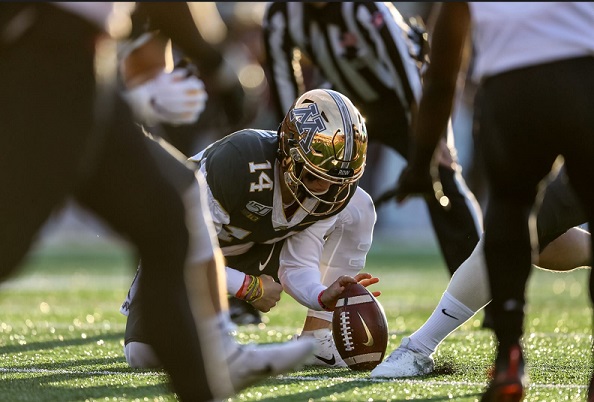
Other Upcoming Water Operator Schools
In addition to the Metro District Water Operator School, three other district schools conducted by the Minnesota Department of Health and Minnesota Section of American Water Works Association will be held this spring.
Southeast District School—Wednesday, March 15 to Friday, March 17 at the International Event Center in Rochester. Topics include trenchless technologies, lead service line inventories and replacements, chemical feed maintenance, and hydrant maintenance. The school will include a vendor show on the first afternoon.
Southwest District School—Wednesday, April 12 at the Redwood Area Community Center in Redwood Falls. Topics include iron and manganese, wellhead protection and source water implementation grant opportunities, and hydrant operations and maintenance.
Northeast District School—Tuesday, April 18 to Thursday, April 20 at Timberlake Lodge in Grand Rapids. In addition to a vendor show and an off-site tour, topics for the school include PFAS and a regulatory update.
All the schools will offer certification exams. The Southeast and Northeast schools will include exam prep sessions.
Go to top
New Robbinsdale drinking water plant looks to the future
By Alycia Overbo, Minnesota Department of Health (MDH)
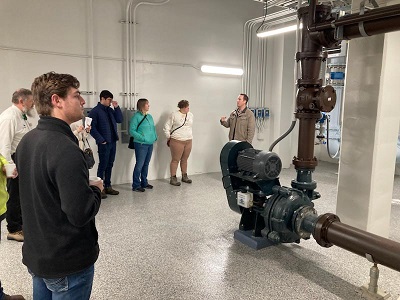
Aaron Vollmer of AE2S, the engineering firm for Robbinsdale’s new water treatment plant, led a tour of the new facility.
Approaching Robbinsdale’s new drinking water treatment plant, one can peer into the windows and get a glimpse of the extensive infrastructure used to treat and deliver its drinking water. This view into the drinking water treatment process is just one of the innovative features that was meticulously researched and planned by the public water system staff and consulting engineering firm AE2S.
Before the new plant went online in November 2022, the community relied on three drinking water plants built in the 1960s. In 2017, the city council authorized a study to identify needs and actions that would ensure the reliability of its drinking water into the future. At the time, the city treated its drinking water only to remove iron and manganese and to add chlorine and fluoride.
“For a system to move from just a regular groundwater iron and manganese filtration to softening, it’s a huge deal. I mean, a huge deal,” commented MDH district engineer Brian Noma. Apart from the additional equipment needs, centralized softening requires extensive water testing and chemical analyses throughout the treatment process.
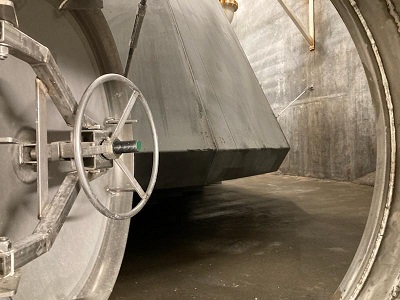
Two looks at the softening cone.
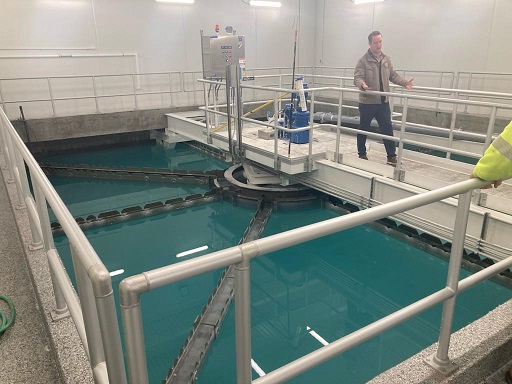
At public meetings, residents requested that the new drinking water plant centrally soften the water, even though it can result in higher water bills. At 24 grains per gallon, Robbinsdale’s groundwater source is very hard and most neighboring communities have centrally softened water.
With centralized softening, the finished drinking water hardness was reduced from 24 to 5 grains per gallon, reducing or eliminating the need for home water softening. Decreased home softening can reduce chloride pollution, which has negative impacts on species such as dragonflies and freshwater mussels. Over-softening water can also cause plumbing issues such as pinholes in copper piping. Robbinsdale shared information with residents about bypassing or calibrating their softeners with the centrally softened water, and Culligan also notified community members about the change. The Metropolitan Council is sampling to understand the chloride reductions in the community wastewater as a result of centralized softening.
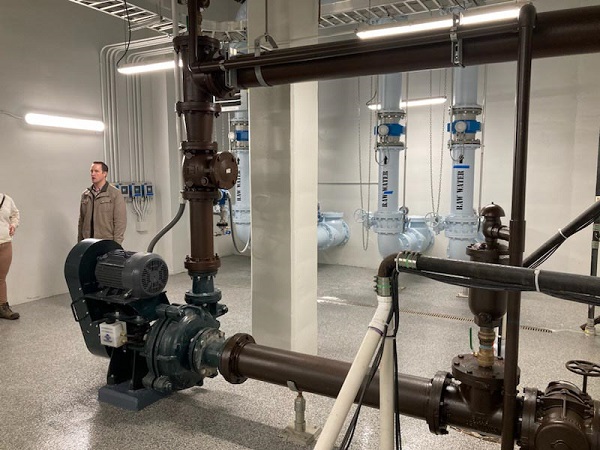
The sludge pump at Robbinsdale's plant.
A bigger site was needed to accommodate lime softening treatment, and the city had an undeveloped plot within a residential area. The neighboring residents were initially wary but ultimately fully supportive of the new drinking water plant, and the utility wanted to design a site that would fit in with the neighborhood. “We didn’t want the building to look like a bunker—not utilitarian,” added Richard McCoy, the city’s public works director.
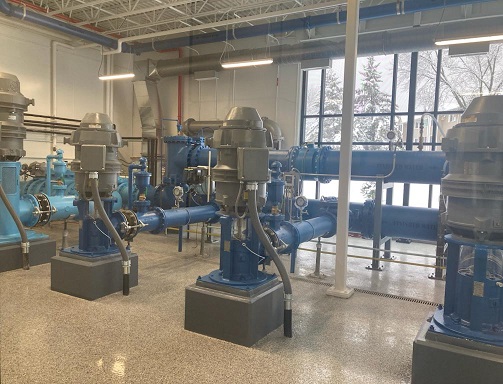
High service pumps.
All of the facility equipment is housed indoors to fit in with neighborhood aesthetics, which also makes maintenance easier. Most pipes are exposed within the plant, making maintenance much easier in the long run. The site also incorporates natural light where possible.
The public water system staff toured other drinking water treatment plants to get ideas for the new plant design. Submarine hatches to access the clarifier were one feature they borrowed from Fairmont, which allows operators to get in and out of areas from different levels without ladders, creating easier access and better safety.
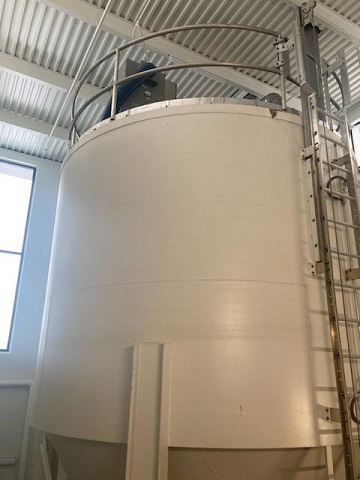
Robbinsdale's lime storage (above) and lime grit removal (below).
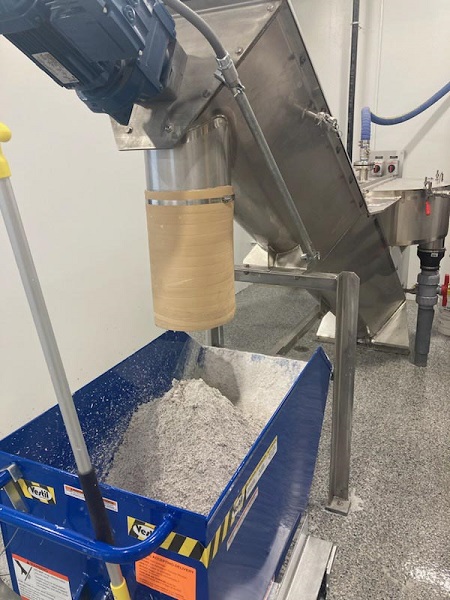
“From the start, we were looking at the long-game—let’s put in features that are going to serve us well for the long term,” said McCoy.
The site also has green features to minimize its environmental footprint. There is a green roof with foliage to capture rainfall and a stormwater pond that ensures no stormwater leaves the site. In the future, the plant will install solar panels on the roof and grow hops on the outdoor trellis with the intent of making them available to one (or both) of the local breweries.
With the new drinking water plant online, the public water system is now shifting to other drinking water infrastructure needs. The system will decommission two of its wells in a vulnerably geologic area near downtown and has already connected two new wells. The system is decommissioning two water towers—the small iconic tower downtown and the one that is surrounded by North Memorial Hospital—and is constructing a new water tower, which is taller and bigger. The infrastructure needs are planned to accommodate population growth and future demand.
Commented McCoy, “We’ll have all the big-ticket items done. Then it will just be the 100-year-old pipes!”
Go to top
Corey Larson joins MDH
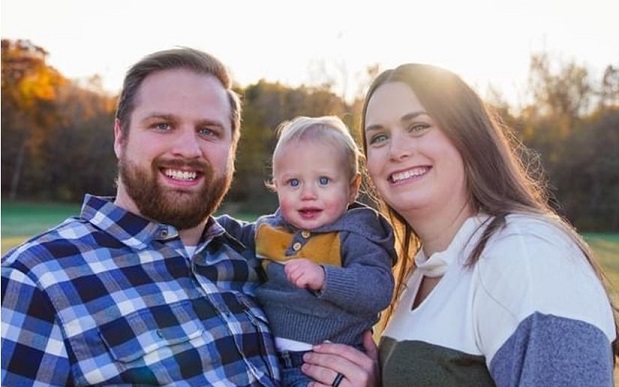
Corey Larson has joined the Drinking Water Protection Section of the Minnesota Department of Health as the Metro Operations Supervisor for the Community Public Water Supply Unit.
Corey grew up on a farm in Mondovi, Wisconsin, just south of Eau Claire, and got his engineering degree at the University of Wisconsin, Madison. He worked for the Wisconsin Department of Natural Resources in various programs for more than 12 years, the last seven of them in drinking water. He enjoys watching and participating in sports along with outdoor activities, particularly fall bow hunting on his parents’ farmland.
Corey lives in Hudson, Wisconsin, with his wife, Ana, and son Owen.
Go to top
Rick Wahlen honored
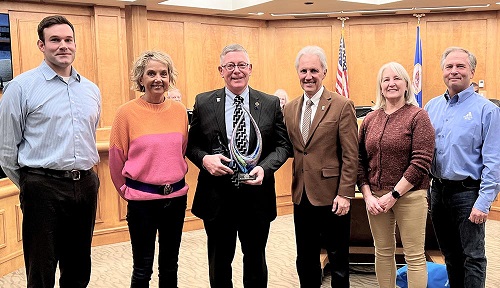
Eden Prairie utility manager and water superintendent Rick Wahlen (holding award) was honored at a city council meeting for awards he has received over the last two years from American Water Works Association (AWWA). In 2020 Rick received the Minnesota AWWA’s Jon Eaton Excellence in Volunteering Award for his legislative and regulatory leadership and years as an officer on the Water Utility Council. In 2021 he was one of the recipients of the Minnesota AWWA’s Andrew Sullivan Outstanding Achievement Award for his work and program development on the Water Utility Treatment and Technology Committee. He also received AWWA’s highest honor, the George Warren Fuller Award.
Because of the pandemic, the awards and recognition had been postponed. A native of South Dakota, Rick served in the Army and was the water superintendent in Aberdeen, South Dakota, before coming to Eden Prairie in 2006. To Rick’s left in the photo is Eden Prairie mayor Ron Case. The others, from left to right, are members of the Minnesota AWWA Awards Committee, Ben Feldman, Carol Kaszynski, Carol Blommel Johnson, and Bert Tracy.
Go to top
Minnesota AWWA participates in Future City Competition
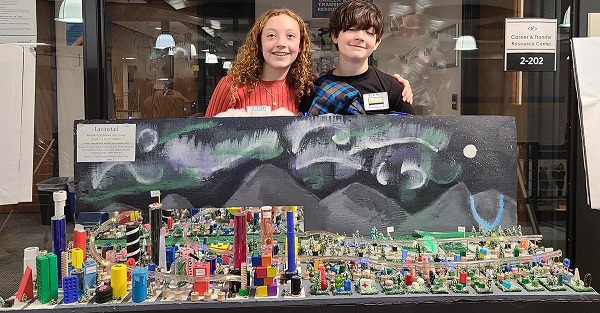
Climate change was the topic for the 31st annual Future City Competition among sixth-to-eighth-grade STEM (Science, Technology, Engineering, and Mathematics) students. The Minnesota portion of the competition was held in Dakota County January 21 with Minnesota AWWA members helping to judge by reviewing 17 projects that focused on water management and conservation.
More than 55,000 students from 1,500 middle schools in the United States (in addition to three teams from China) competed by researching and designing a solution to a city-wide issue. This year students were challenged to design a futuristic climate-change adaptation and mitigation strategy to keep their residents healthy and safe.
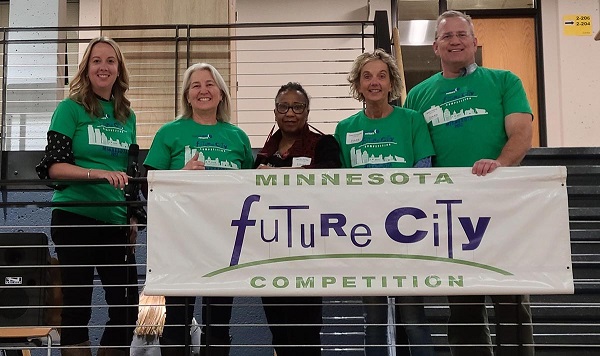
Left to right: Michelle Stockness, Carol Blommel Johnson, Marilyn Porter of the Metropolitan Council, Carol Kaszynski, and Steve Gilberg. (The ones in the green shirts are Minnesota AWWA members.)
Go to top
Cool web sites
Go to top
Quote of the quarter
“It’s a dangerous thing to mistake speaking without thought for speaking the truth.” —Benoit Blanc
Go to top
Reminder to all water operators
When submitting water samples for analyses, remember to do the following:
- Take coliform samples on the distribution system, not at the wells or entry points.
- Write the Date Collected, Time Collected, and Collector’s Name on the lab form.
- Attach the label to each bottle (do not attach labels to the lab form).
- Include laboratory request forms with submitted samples.
- Do not use a rollerball or gel pen (the ink may run).
- Consult your monitoring plan(s) prior to collecting required compliance samples.
Notify your Minnesota Department of Health district engineer of any changes to your systems.
A Mnemonic Summary
If you have questions, call the Minnesota Department of Health contact on the back of all sample instruction forms.
When taking water samples, do it on the distribution system
And not at the well or entry points. Note the date collected,
Time collected, and collector’s name on the lab request form.
Each bottle should have its own label.
Resist the urge to attach the labels to the lab form.
Lab request forms accompany the submitted samples.
Ink from gel or roller-ball pens may run. Use a ball-point pen.
Never collect required compliance samples without consulting your monitoring plans.
Engineers (MDH district engineers) will want to know of changes to your systems.
Thanks to MDH alumna (and expert proofreader) Lonna Wolfsteller for the summary.
Go to top
Calendar
Operator training sponsored by the Minnesota Department of Health and Minnesota AWWA will be held in the coming months.
Register for schools and pay on-line:
Go to top